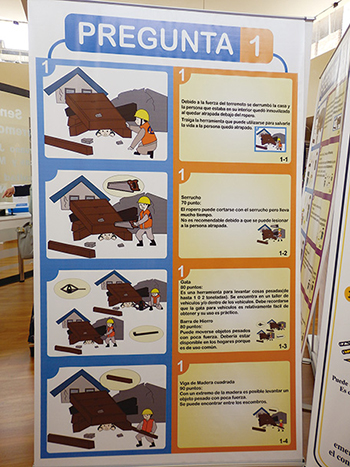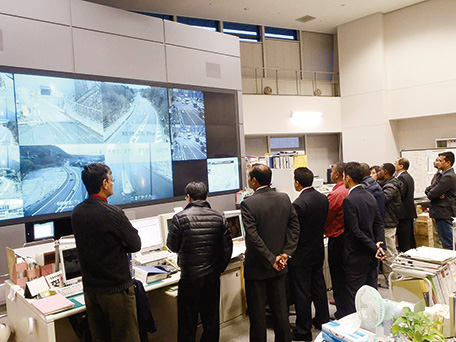(3) Mainstreaming of Disaster Risk Reduction; Disaster Risk Reduction and Post-Disaster Recovery Measures
Disasters involving earthquakes, tsunamis, typhoons, floods, debris flows, and other natural events that occur frequently around the world do not merely take human lives and property. In developing countries that are vulnerable to disasters, the poor suffer from significant damage and become displaced in many cases. In addition, secondary damage such as the deterioration of sanitary conditions and food shortages may become protracted, making the problem more severe. In this respect, disasters have a significant impact on the overall social and economic mechanisms of developing countries.
Against this backdrop, it is necessary to build a disaster-resilient society to protect human lives from disasters, as well as to promote the “mainstreaming of disaster risk reduction,” aiming at sustainable development, by incorporating disaster risk reduction measures into every phase of every sector of development, based on assumptions of disasters of various scales.
< Japan’s Efforts >
| Cooperation in disaster risk reduction
Japan utilizes its superior knowledge and technology acquired through past experiences of responding to natural disasters such as earthquakes and typhoons to provide proactive support for disaster risk reduction and post-disaster recovery measures, alongside emergency assistance.
In 2005, at the Second UN World Conference on Disaster Reduction in Kobe, the Hyogo Framework for Action 2005-2015 was adopted as a basic guideline for disaster risk reduction activities in the international community, which affirmed the importance of effectively incorporating disaster risk reduction aspects into initiatives for sustainable development.
At this conference, Japan also announced the Initiative for Disaster Reduction through ODA, which represents Japan’s basic policy on disaster risk reduction cooperation. In this policy, Japan expressed its intention to continue proactively supporting the self-help efforts by developing countries towards “building a disaster-resilient society” through the building of systems, human resources development, development of socio-economic infrastructure, and other measures.
In July 2012, Japan hosted the World Ministerial Conference on Disaster Reduction in Tohoku in three prefectures affected by the Great East Japan Earthquake. During the conference, the following aspects were affirmed and the necessity of “Disaster Reduction in the 21st Century” as a comprehensive way to promote these aspects was proposed to the world: the necessity of mainstreaming disaster risk reduction and building resilient societies; the importance of human security; the need to maximize combining both structural and nonstructural disaster risk reduction capabilities; the necessity of collaboration beyond the roles of various stakeholders; the importance of responding to newly emerging disaster risks such as climate change and urbanization. Participants in the conference also confirmed the positioning of disaster risk reduction in the 2030 Agenda for Sustainable Development, as well as the need for formulating the post-Hyogo Framework for Action that incorporates the results of this conference, in order to actually promote “Disaster Reduction in the 21st Century.” Japan also pledged to provide $3 billion in three years from 2013 to 2015 to support initiatives in the disaster risk reduction field.
The Third UN World Conference on Disaster Risk Reduction was held in Sendai City from March 14 to 18, 2015. This conference organized by the UN is held in order to discuss international disaster risk reduction strategies. Since Japan proactively promotes international disaster risk reduction cooperation utilizing its knowledge and experiences in disaster risk reduction, Japan was once again the host country for the third conference, following its hosting of the first conference in 1994 in Yokohama and the second conference in 2005 in Kobe. The third conference was attended by more than 6,500 people representing 185 UN member states. When including related events a total of more than 150,000 people from Japan and other countries took part, making it one of the largest-ever international conferences held in Japan. (See “ODA Topics” for more information.)
In hosting this conference, Japan aimed to achieve the following three goals;
(i) To introduce the perspective of disaster risk reduction in the planning and implementation of various policies (mainstreaming of disaster risk reduction)
(ii) To transmit Japan’s knowledge and technology concerning disaster risk reduction, and
(iii) To provide information regarding the reconstruction from the Great East Japan Earthquake and to contribute to the recovery of the disaster-affected areas.
The conference resulted in the adoption of the Sendai Declaration as well as the Sendai Framework for Disaster Risk Reduction 2015-2030 (Sendai Framework), which is the successor to the Hyogo Framework for Action, the international guiding principle for disaster risk reduction adopted at the second conference. The Sendai Framework incorporated Japan’s declarations about the importance of investment in disaster risk reduction, the involvement of diverse stakeholders, the concept of “Build Back Better,” the importance of women’s leadership, etc.
Prime Minister Shinzo Abe announced the Sendai Cooperation Initiative for Disaster Risk Reduction as Japan’s new contribution plan that will become Japan’s future basic policy for cooperation in the field of disaster risk reduction. Japan announced that in the four years from 2015 to 2018, it will provide $4 billion in total to the area related to disaster risk reduction and train 40,000 officials to play a leading role in national efforts for disaster risk reduction and post-disaster reconstruction. Through this initiative, Japan demonstrated its attitude to further contribute to the international community by utilizing its advanced knowledge and technology in the field of disaster risk reduction.
At the UN summit that adopted the 2030 Agenda for Sustainable Development in September 2015, Prime Minister Abe expressed Japan’s commitment to lead the implementation of the Sendai Framework, and encouraged other countries to adopt the resolution on the UN’s World Tsunami Awareness Day as a means of raising awareness about tsunami. As a result, a resolution was adopted at the General Assembly of the UN held on December 22, 2015 (local time) to establish November 5 as World Tsunami Awareness Day.
Peru
Project for Enhancement of Earthquake and Tsunami Disaster Mitigation Technology
Technical Cooperation Project – Science and Technology (March 2010 – March 2015)

Disaster risk reduction educational materials for children. (Photo: JICA)
Peru is located in the seismically-active Pacific Rim, and susceptible to earthquakes and tsunami, like Japan. Natural disasters have seriously hindered Peru’s social and economic development. For example, a magnitude 8.4 earthquake struck Peru’s southern coast on June 23, 2001. It resulted in over 100 victims and more than 40,000 buildings destroyed.
A magnitude 8.0 earthquake also occurred off the coast of Pisco in the Ica Region in Central Peru on August 15, 2007, causing more than 500 victims and destroying over 80,000 buildings. Many poor people in the region live in houses made of adobe, and they suffered the most because their houses could not withstand such a major earthquake.
Both of these were trench-type earthquakes, which occur regularly. This means that similar earthquakes and tsunami will occur in the future. Therefore, damage mitigation is very important. To that end, Peru needs to be able to scientifically predict the risk of an earthquake or tsunami occurring and the potential damage, and then implement specific measures based on the findings. This would also help Peru mitigate the damages.
The Government of Japan helped establish the Japan-Peru Center for Earthquake Engineering and Disaster Mitigation (CISMID) as part of the Japan-Peru Center for Earthquake Engineering and Disaster Mitigation Project implemented from 1986 to 1991. CISMID has worked with JICA, and Japanese universities and research institutions, for nearly three decades since.
Japan and Peru launched the Project for Enhancement of Earthquake and Tsunami Disaster Mitigation Technology in 2010. This project promoted the research and development of technologies for accurately predicting and mitigating the risk of damages caused by future earthquakes and tsunami, and also was conducted by CISMID on the Peruvian side and Chiba University on the Japanese side. Through this project, they established scenarios of future earthquakes that could result in catastrophic damages, and conducted simulations and damage predictions based on these scenarios. They also analyzed these scenarios using the latest methods and data on anti-seismic technologies. These results were then used to raise awareness about disaster preparedness.
The Peruvian researchers are now working with the government to utilize the new knowledge and technologies from this project, to create hazard maps and revise building standards. They are also working on capacity building initiatives with related institutions. In future, this project is thus expected to contribute to human resource development in the disaster mitigation field in Central and South America. (As of August 2015)
Mauritius
The Project for Landslide Management
Technical Cooperation for Development Planning (April 2012 – April 2015)

Participants in the project on a training program in Japan visit the Control and Monitoring Center in the Kanto Regional Development Bureau, the Ministry of Land, Infrastructure, Transport and Tourism. (Photo: Kokusai Kogyo Co., Ltd.)
Mauritius is a small volcanic island that is about the size of Tokyo Prefecture. There are many steep slopes on the island that pose a very high risk of landslides. An increasing number of people and houses have shifted onto these slopes, as Mauritius’ population and urban centers have continued to grow. The communities on these slopes are especially at risk, and serious damages are caused every time a landslide occurs.
Large-scale landslides occurred in the western part of Port Louis, the capital of Mauritius, causing massive damage from 1986 to 1987. In response, the Government of Japan began providing assistance for various landslide countermeasures in 1989, which has helped to prevent landslides in this district. However, large-scale landslides once again occurred in the northern part of Port Louis in March 2005.
The Government of Mauritius set up the National Disaster Risk Reduction and Management Council in order to improve its preparations for landslide disasters, and established the Landslide Management Unit (LMU) and Repair and Rehabilitation Unit (RRU) within the Ministry of Public Infrastructure and Land Transport (MPI) in 2009. Despite these efforts, Mauritius was only able to implement limited countermeasures given its limited human resources.
Furthermore, Mauritius had very few experts on geological engineering. Therefore it did not have the necessary expertise to identify or monitor the risk of landslides, nor improve land usage in high risk areas. Given this background, Mauritius asked Japan to assist in creating fundamental landslide countermeasures for disaster mitigation. Japan conducted a survey on the state of landslide-prone areas and on damages to houses in Port Louis.
Japan also provided instructions on how and where to install the extensometers and pipe strain gauges donated by the project. A technical transfer seminar was subsequently held in Mauritius. It was attended not only by members of the MPI, but also members of landslide-related institutions and universities. The seminar featured very active discussions. In addition, this project donated and installed various landslide observation equipment, such as inclinometers and ground extensometers. This made it possible to gather specialized data. Five MPI officials were invited to attend training in Japan in 2012, which included a visit to the monitoring office of the Kanto Regional Development Bureau of the Ministry of Land, Infrastructure, Transport and Tourism.
This cooperation is expected to improve the landslide management capabilities of RRU and LMU, and assist the formulation of a landslide management plan.
